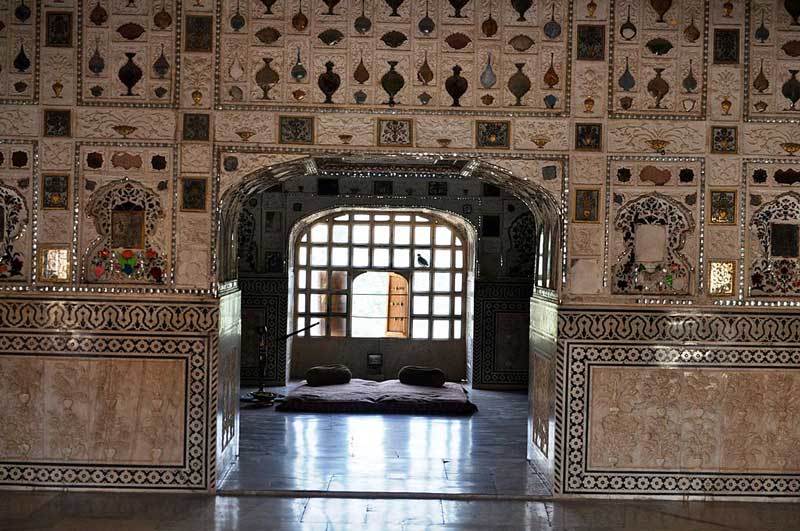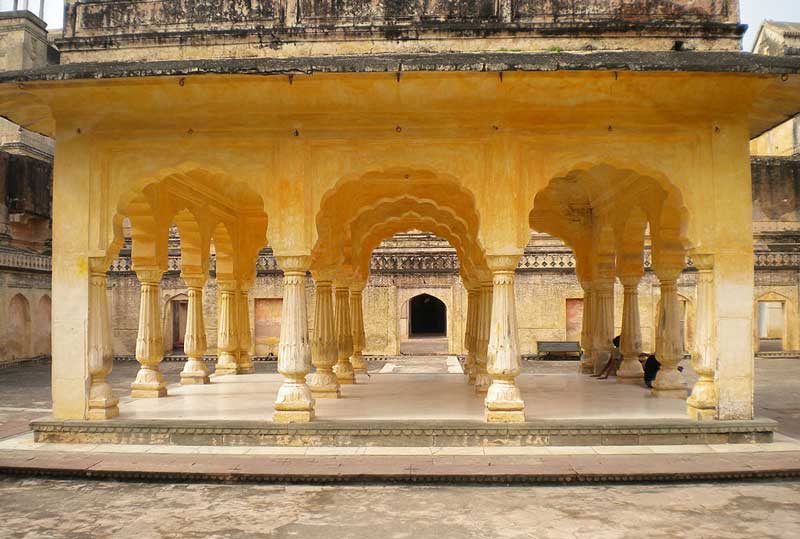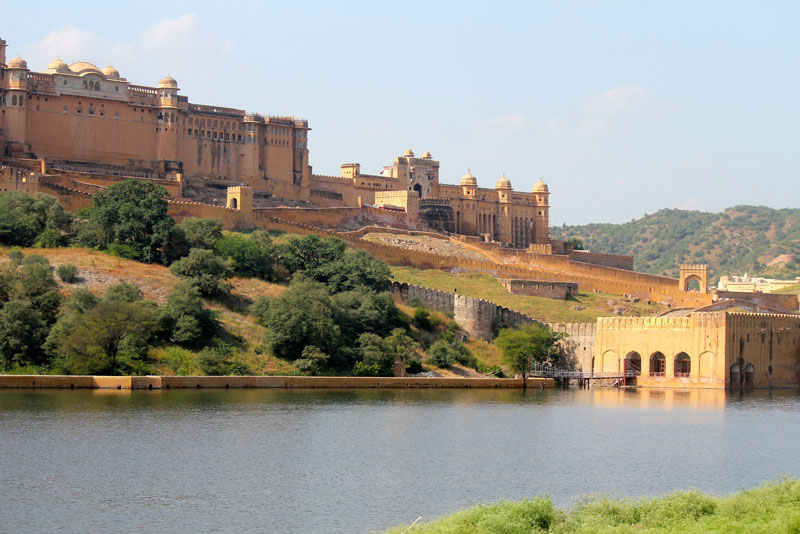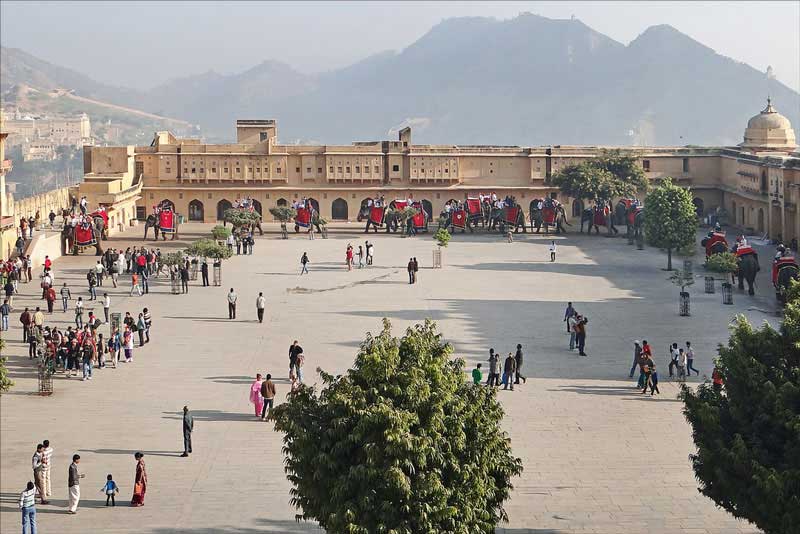The prized architectural jewel of Jaipur, the Amber fort is located in the medieval town of Amer, which is at a short distance of 10 kilometers from Jaipur. The fort was said to have been constructed by the Rajput King Raja Man Singh of Amer in the late 16th century and expanded by Raja Jai Singh I, before the capital was shifted to Jaipur. The fort is impressively well preserved and boasts of a striking architecture and combines different styles from Hindu, European and Persian building designs.
Most of the structures in the fort feature the signature Chatri and is decorated with intricate carvings and stone lattice work known as ‘jalis’. The entry to the base of this grand citadel is marked by the manmade Maota Lake that features an eye catching flower garden known as Kesar Kyari (Saffron Orchard), built in a typical Persian style. The fortress walls are made of red sandstone, with marble Chhatris and painted in a yellowish amber color.
The palatial structure itself is divided into 4 sections with individual entrances and central courtyards. The main entrance is named the Suraj Pol and is located towards the east and leads straight to the main courtyard named ‘Jaleb Chowk’. Entering the fort on foot or Elephant, you will enter through the Suraj Pol gate, which directly leads to Jaleb Chowk. Entering the fort by car will take you through Chand Pol gate, located on the opposite side of Jaleb Chowk, but near the Shila Mata Temple.
Light and Sound Show – If you want to know more about the history of Amer and Jaipur, then it is important that you visit this show. Organized every evening at the Amer fort complex, this light and sound show is conducted in both Hindi and English at the Kesar Kyari garden. The show lasts for 50 minutes and provides a brief yet enchanting look at the colorful culture of Jaipur.
Amber by Night – With a view of promoting night time tourism in Jaipur, the government has recently inaugurated the “Amber by Night”. This involves a brief tour of some of the most exquisite areas of the fort such as Sheesh Mahal, Jaleb Chowk, Mansingh Mahal and Diwan-e-Aam. These areas were chosen, as they appear to be totally different during the night time.
Entry Timings
- Day– 8:30 am to 5:30 pm
- Night – 7:00 pm to 10:00 pm (Only Jaleb Chowk, Diwan-e-Aam, Mansingh Mahal and Sheesh Mahal are open for viewing)
- Light and Sound Show – 7:30 pm (Hindi), 8:30 pm (English)
Entry Fee
- Day
- Indian: INR 25
- Foreigners: INR 200
- Indian Students: INR 10
- Foreign Students: INR 100
- Night
- Indian: INR 100
- Foreigners: INR 400
- Light and Sound Show
- Hindi: INR 100
- English: INR 200
From Amber Base to the Top
When visiting the fort, you can choose to go all the way from the base to the top by foot or you can hire a jeep or an elephant. Jeep rides are available all day. Elephant rides however, start from 8.00 am and are only available till 11.00 am. The return trip only happens during the evening, before the fort is closed for visitors so it is better to take a jeep on your way back.
Jeep Ride to the Fort
- Timings: 8:00 am to 6:00 pm all days
- Fee: INR 150/Person (One Way)
Elephant Ride to the Fort
Timings
- Morning –7.00 am to 11.00 am summers, 7.00 am till 12.00 pm Winters
- Evening –3:30 pm till 5:30 pm
- Fee: INR 900 for 2 People (One Way)
Important: If one is good at driving, they can also take their personal car to the parking spot inside the fort and save all the additional fees. You might have to pay the parking fee, which will not be more than INR 30-40. If you have hired a cab to Amer, the driver will take you right to the parking spot inside the fort.
Listed Below Are the Places You Should Definitely Visit In Amer
-
Jaleb Chowk
Is said to be the main gathering place for the soldiers. During the reign of Raja Jai Singh, Jaleb Chowk was used for several parades by the Maharaja’s personal bodyguards. The word ‘Jaleb Chowk’ is a Persian word, which translates to a place where soldiers assemble. The structures located at the upper levels were used as residential quarters by the guards with the horse stables located right next to Jaleb Chowk.
-
The Diwan-I-Aam
Diwan-I-Aam is another interesting area in Amer, which was the public audience hall during the older times. The structure is marked by a raised platform with a roof that is supported by 27 pillars. Each of the pillars is intricately carved and decorated with elephant motifs and frescoes.
-
The Shila Devi temple
Shila Devi Temple is dedicated to an incarnation of the Hindu goddess Shakti. Shila Devi is said to be the patron deity of the Rajput rulers of Jaipur and has a very interesting story related to its consecration within the fort. The temple’s entrance is marked by an intricately carved double door, which is covered in silver sheet and 2 lion sculptures made of pure silver can be found beside the chief deity of the temple. One can also see a beautiful carving of Lord Ganesha near the entrance that is carved from a single piece of coral. The idol of Shila Mata is said to be carved from a single block of stone, which is also linked to the story of Lord Krishna.
-
Sukh Niwas
Sukh Niwas was said to be the resting quarters of the Royal family, where the Maharaja used to spend time with the queens and the mistresses. The place is an architectural marvel for its time as it contained a specialized water canal that kept the enclosure cool during the day time and can be termed as ‘Medieval Air-Conditioning’.
-
Sheesh Mahal

Photo by Rangarajan V, CC BY-SA 3.0
Sheesh Mahal or the Glass Palace is one of the most astounding structures in the fort. The interior walls of this picturesque enclosure are marvelously decorated with studded glasswork and colorful murals made with foil. In low light conditions, just two candles are enough to illuminate the room as the light is reflected by the several mirrors on the walls and ceilings.
-
Man Singh I’s Palace

Photo by Vssun, CC BY-SA 3.0
Man Singh I’s Palace is said to be one of the oldest parts in the Amber fort. Like its name suggests, the structure was built by Raja Man Singh I of Amer and is considered to be the main residential place for the royal family. The exterior and interior walls of this structure are intricately designed with frescoes, carvings and colorful paintings that reflect the grandeur of the Rajputs of Jaipur. The central structure is also known as the ‘Baradari’ and has an ornamental roof supported by 12 pillars.

